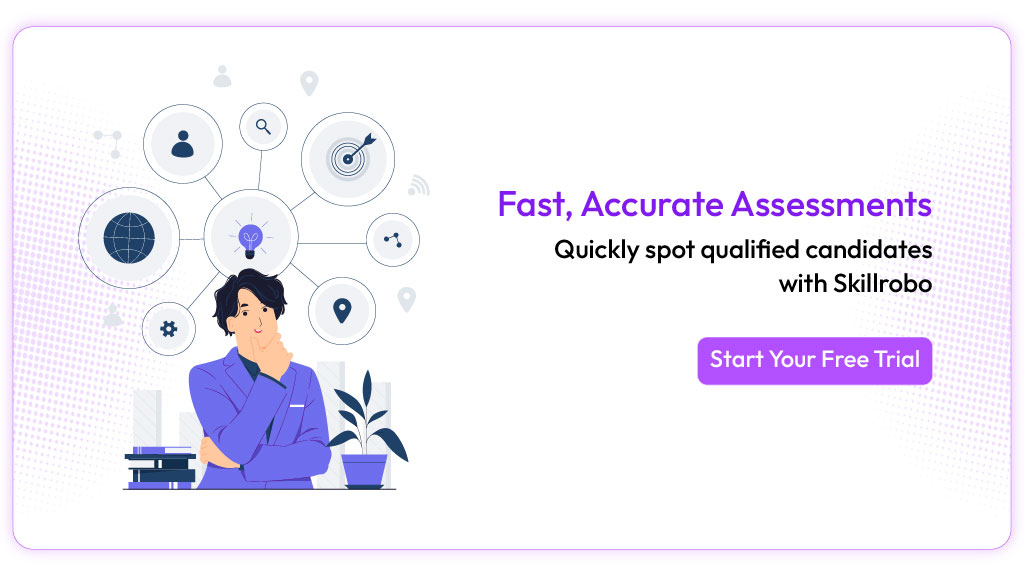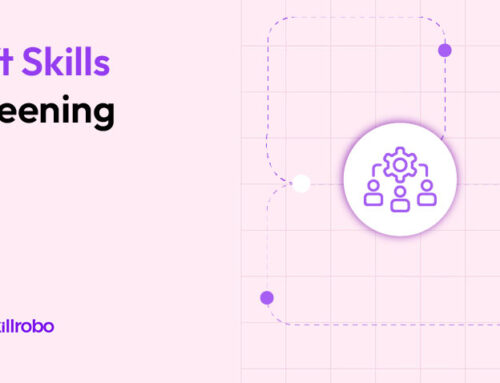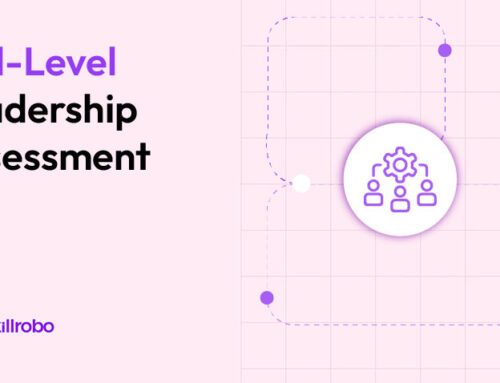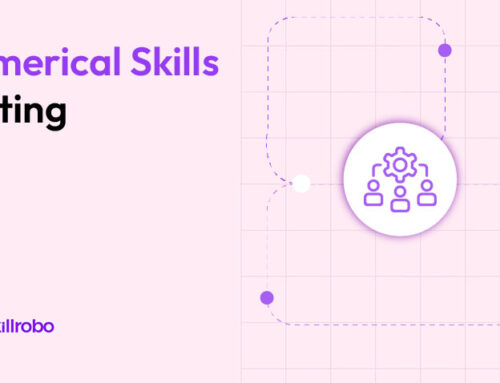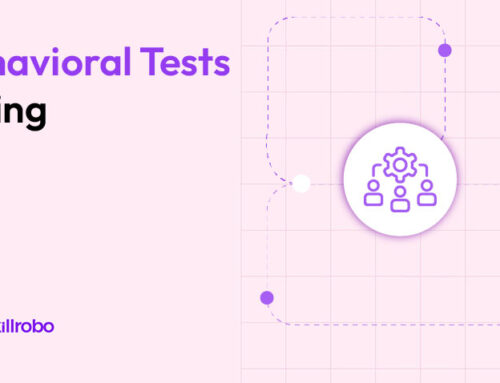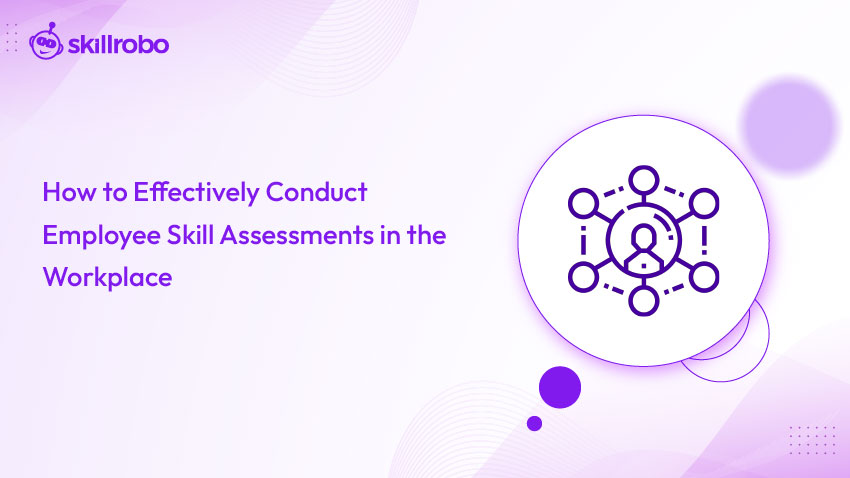
Key Takeaways
- Employee skill assessments identify strengths, gaps, and training needs in a structured, data-driven way, enabling organizations to build more capable teams.
- Structured evaluations improve hiring, retention, succession planning, and employee engagement, leading to stronger business outcomes and a more agile workforce.
- Tools like Skillrobo simplify creating customized skill tests for various job roles, ensuring that assessments are both relevant and efficient.
- A combination of technical, cognitive, and behavioral assessments provides a holistic view of workforce capabilities, allowing companies to make smarter, long-term talent decisions.
Why Employee Skill Assessments Are Critical in Today’s Workplace
The skills landscape is evolving faster than ever. According to LinkedIn’s 2024 Workplace Learning Report, 58% of organizations prioritize closing skill gaps this year. As technology adoption accelerates and hybrid work becomes mainstream, companies must continually evaluate and upskill their workforce to stay competitive.
Traditional performance reviews or gut-feel promotions are no longer enough. They often fail to capture the real abilities and development potential of employees. In contrast, structured employee skill assessments provide objective, measurable insights into individual capabilities.
Here’s why skill assessments are crucial in today’s workplace:
1. Ensuring employees have the right capabilities to meet business goals: Skill assessments help confirm whether current teams have the expertise needed to achieve strategic objectives.
2. Identifying future leaders early: By assessing leadership potential systematically, organizations can build a strong succession pipeline.
3. Designing personalized learning and development programs: Assessment results pinpoint exactly where skill gaps exist, allowing for tailored upskilling initiatives.
4. Reducing bias in promotions and hiring decisions: Objective, standardized evaluations ensure fairness and minimize unconscious bias.
In this blog, we’ll show you how to build a high-impact skill assessment strategy—and how tools like Skillrobo make the process seamless and efficient.
What Are Employee Skill Assessments?
An employee skill assessment is a standardized evaluation that measures an individual’s proficiency in specific competencies critical for success in a particular role. These assessments go beyond resumes, interviews, and subjective manager reviews by providing objective, measurable insights into employee abilities.
Skill assessments typically evaluate a combination of:
- Technical skills: such as proficiency in Microsoft Excel, coding languages, or project management tools.
- Cognitive skills: such as logical reasoning, critical thinking, and problem-solving abilities.
- Behavioral skills: such as communication, teamwork, leadership potential, and adaptability.
To ensure that assessments are aligned with business goals, companies often use competency assessment tools that structure tests according to job descriptions, career paths, and organizational needs. This approach ensures that the skills being evaluated directly impact job performance and employee growth.
How to Conduct Effective Skill Assessments (Step-by-Step)
Building a skilled and future-ready workforce requires more than relying on resumes, interviews, or gut feelings. Effective skill assessments are a strategic tool to evaluate employee capabilities objectively and consistently. They help you identify high-potential talent, uncover hidden skill gaps, and design targeted development plans that align with business goals.
However, conducting skill assessments the right way involves a structured, thoughtful process. Randomly chosen tests or generic evaluations can result in inaccurate insights, wasted resources, and missed opportunities for growth. A step-by-step approach ensures your assessments are role-specific, secure, and truly predictive of real-world performance.
In this section, we’ll guide you through a detailed step-by-step framework for creating skill assessments that are:
1. Define Critical Skills Per Role
Start by clearly identifying the core skills required for every role in your organization.
This step ensures that assessments measure abilities directly tied to real business outcomes, not just generic competencies.
Work closely with team leaders, department heads, and HR to map out the technical, cognitive, and behavioral skills needed for each position. Review existing job descriptions, performance goals, and KPIs.
Analyzing what top performers do differently can also provide valuable insights into critical success factors.
Tip: Use a competency framework to organize skills into categories such as technical (e.g., MS Office proficiency), cognitive (e.g., logical reasoning), and behavioral (e.g., communication). This structure makes it easier to align assessments with broader workforce planning initiatives.
If you’re hiring, it’s important to understand the types of assessments used to structure smarter hiring processes here to ensure role relevance.
2. Select the Right Assessment Methods
Not every skill should be evaluated the same way. Different competencies require different approaches to accurately measure a candidate’s ability. Choosing the correct assessment method is critical for getting reliable and actionable results.
Relying on a one-size-fits-all testing approach can lead to misleading conclusions about a candidate’s readiness or potential. Instead, selecting the right mix of assessment methods ensures that each skill—whether technical, cognitive, or behavioral—is evaluated in a way that truly reflects real-world performance.
Here are some of the most common and effective methods used in skill assessments:
- Practical Tests: Use hands-on exercises such as Excel spreadsheet tasks, coding assignments, or document creation to assess technical skills.
- Situational Judgment Tests (SJTs): Present candidates with real-world workplace scenarios to evaluate decision-making, problem-solving, and prioritization under pressure.
- Behavioral Assessments: Assess soft skills like teamwork, leadership potential, adaptability, and communication.
Skillrobo’s communication skills assessment tool helps organizations evaluate vital soft skills like listening, clarity, and collaboration, especially for hybrid and remote teams where communication challenges are amplified.
3. Customize Tests Based on the Role
Generic assessments rarely deliver meaningful results. While standardized tests might offer basic insights, they often fail to capture the unique demands of specific roles within an organization. Customization ensures that skill assessments accurately reflect the competencies truly needed for success in each position.
Tailoring assessments to different job functions, departments, and levels of seniority makes the evaluation process more relevant, targeted, and predictive of real-world performance. For example, the skills required for an entry-level administrative assistant will differ significantly from those needed by a senior project coordinator. By customizing your tests, you can better measure job-specific abilities, identify top talent, and ensure a stronger fit between the candidate and the role.
Example:
- For administrative assistants, prioritize skills like attention to detail, task organization, time management, and written communication. You can learn how to create precise assessments with administrative skill tests.
- For sales professionals, focus on negotiation skills, CRM tool proficiency, client handling techniques, and emotional intelligence.
Customization ensures candidates are tested on the competencies they will actually use in their daily work, leading to better hiring, stronger onboarding, and improved job satisfaction.
It’s also important to adjust difficulty levels based on seniority (entry-level vs. managerial) to ensure fair evaluation across different experience levels.
4. Ensure Secure and Fair Testing
Online skill assessments are highly convenient, especially in today’s remote and hybrid work environments, but they must be protected against fraud, bias, and technical vulnerabilities. Without proper safeguards, assessment results can be compromised, leading to poor hiring decisions and reputational risks.
A secure and fair testing environment not only builds candidate trust but also ensures the validity and accuracy of your results, giving hiring managers confidence that they are evaluating true capabilities rather than manipulated outcomes.
To maintain the integrity of your skill assessments, use platforms that offer features such as:
- Browser Lockdown: Restrict candidates from navigating away from the test window during assessments.
- Randomized Question Pools: Present different sets of questions to each candidate to minimize sharing and repetition.
- Time-Bound Tests: Set appropriate time limits to ensure assessments are completed independently.
- AI-Driven Proctoring: Leverage AI monitoring tools that detect suspicious behaviors during the test, such as unusual eye movements or external assistance.
If you’re concerned about cheating or test security, learn more about the risks and how to mitigate them. Secure testing ensures that assessment outcomes are reliable, fair, and reflective of genuine ability.
5. Analyze Data and Take Action
Collecting assessment data is just the beginning—what you do with the insights matters even more. Simply gathering scores and reports won’t move the needle unless the information is used strategically. Skill assessment data should become a foundation for smarter talent decisions, stronger workforce planning, and continuous organizational improvement.
When properly analyzed and acted upon, assessment results can uncover hidden potential, identify skill gaps before they impact performance, and align employee development efforts with business goals. Ultimately, the true value of skill assessments lies in how you apply the insights to build a more capable, engaged, and future-ready workforce.
Here’s how to turn data into action:
- Identify Training Needs: Pinpoint skill gaps at the team or individual level and design targeted learning and development programs to address them.
- Spot Leadership Potential: Use assessments to recognize employees who demonstrate the problem-solving, emotional intelligence, and communication skills needed for future leadership roles.
- Personalize Career Paths: Guide employees into career tracks that align with their strengths, boosting engagement and retention.
- Track Progress Over Time: Repeat assessments periodically to track employee growth, refine succession planning strategies, and measure the ROI of training investments.
By analyzing skill assessment data holistically, HR teams can create dynamic strategies that continuously improve recruitment, onboarding, learning, and internal mobility programs.
Best Practices for Conducting Skill Assessments
Conducting skill assessments correctly ensures you get meaningful, actionable results while also maintaining a positive experience for employees and candidates. Here’s how to maximize the impact of your skill assessments:
1. Communicate Clearly
Before launching an assessment, clearly explain its purpose to employees or candidates. Emphasize that assessments are tools for growth and development, not punitive measures. Transparent communication helps reduce anxiety, builds trust, and encourages participants to approach assessments confidently and honestly.
2. Mix Hard and Soft Skill Evaluation
Technical proficiency alone doesn’t guarantee success in most roles. Incorporate assessments that measure both hard skills (like software proficiency) and soft skills (like teamwork, adaptability, and leadership potential). A balanced evaluation provides a holistic view of an individual’s true capabilities and readiness for future challenges.
3. Keep Assessments Short and Relevant
Long, unfocused assessments can lead to fatigue and inaccurate results. Aim to design assessments that are concise, targeted, and ideally completed within 30 minutes. This maintains candidate focus, improves completion rates, and ensures that the data collected is reliable and meaningful.
4. Offer Feedback
Regardless of assessment outcomes, always provide constructive feedback. Sharing results—highlighting both strengths and areas for improvement—helps employees view assessments as a learning opportunity. Constructive feedback also reinforces a culture of continuous growth and skill development.
5. Combine with Performance Reviews
Skill assessments shouldn’t exist in isolation. Integrate assessment insights with regular performance reviews to create a 360° view of employee capabilities. This combined approach offers a richer understanding of employee strengths, growth areas, and potential career paths within the organization.
Common Mistakes to Avoid
While skill assessments are powerful tools, missteps in the process can undermine their effectiveness. Here’s a list of common mistakes to avoid for a smoother and more impactful assessment experience:
1. Testing for the Sake of It
Skill assessments should have a clear strategic purpose. Avoid conducting tests simply to check a box. Tie every assessment directly to business goals like improving team capabilities, supporting succession planning, or guiding training investments.
2. Using One-Size-Fits-All Tests
A single test won’t meet the diverse needs of different departments or roles. Customize assessments by department, seniority level, and functional requirements to ensure you’re measuring skills that truly matter for success in each role.
3. Overloading Candidates
Excessively long or complex assessments can overwhelm candidates and skew results. Design assessments to be focused, relevant, and manageable so participants can demonstrate their true abilities without feeling exhausted or frustrated.
4. Ignoring Soft Skills
Technical skills are important, but neglecting soft skills like communication, leadership, and collaboration leaves major gaps in evaluation. Make sure your assessments cover interpersonal abilities that are critical for team dynamics and leadership development.
5. Failing to Follow Up
Collecting assessment data is only valuable if it’s acted upon. Use results to drive coaching conversations, mentoring programs, promotions, and career development initiatives. Regular follow-up ensures that assessments lead to real growth and organizational benefits.
How Skillrobo Helps Streamline Skill Assessments
Managing skill assessments can be complex without the right tools. Skillrobo offers a comprehensive, user-friendly platform that simplifies every aspect of the skill testing process—from creation to evaluation—so you can focus on building stronger teams.
Here’s how Skillrobo streamlines skill assessments:
Pre-Built Templates: Access over 100 ready-to-use tests covering technical, cognitive, and behavioral skills. These professionally designed templates allow you to launch assessments quickly and efficiently without starting from scratch.
Customizable Tests: Skillrobo allows you to tailor assessments to match specific job roles, departments, and business needs. Customization ensures that every assessment measures skills that are relevant and predictive of success in your organization.
AI-Based Proctoring: Maintaining test integrity is crucial. Skillrobo’s AI-driven proctoring features help prevent cheating by monitoring candidates during the assessment. Secure testing builds credibility and ensures results reflect true abilities.
Real-Time Reporting: Skillrobo provides instant analytics on candidate performance. Quickly identify skill gaps, benchmark results, and make faster, data-driven decisions with real-time reporting dashboards.
Seamless Integration: Skillrobo easily integrates with your existing Applicant Tracking Systems (ATS) and Human Resource Management Systems (HRMS). This seamless connection ensures that assessment data flows smoothly into your hiring, onboarding, and employee development workflows.
Explore how Skillrobo’s online examination software ensures secure, scalable, and customizable assessments across various functions and industries. With Skillrobo, organizations can assess skills more efficiently, fairly, and confidently—saving time, enhancing candidate experience, and ultimately building stronger teams ready to meet business goals.
Final Thoughts: Strong Skills, Strong Organizations
The future belongs to companies that continuously develop and empower their talent. In an era of rapid technological change and evolving business models, building a resilient, future-ready workforce is no longer optional—it’s essential.
Regular employee skill assessments play a critical role in this transformation. They help organizations stay competitive by ensuring teams possess the right mix of technical, cognitive, and behavioral competencies. Skill assessments also keep employees motivated by identifying clear pathways for growth and recognizing hidden strengths.
However, success isn’t just about conducting assessments—it’s about how seamlessly and strategically they are integrated into your talent management processes. The right tools make all the difference.
Platforms like Skillrobo simplify every stage of skill assessment, from test creation to evaluation, while improving both candidate and employee experiences. They allow organizations to assess skills efficiently, fairly, and at scale—helping drive measurable business growth.
Ready to future-proof your workforce? Try Skillrobo today!
Frequently Asked Questions
1. How often should companies conduct skill assessments?
Ideally, skill assessments should be conducted at least once a year to stay aligned with evolving business needs and employee growth. Additionally, it’s a good practice to assess skills after major role changes, promotions, or completion of significant training programs. Regular evaluations ensure continuous development and workforce agility.
2. What are the most effective types of skill assessments?
The most effective approach is a combination of technical, cognitive, and behavioral tests. Technical assessments measure job-specific skills like software proficiency, cognitive tests evaluate problem-solving and reasoning abilities, and behavioral assessments provide insights into teamwork, communication, and leadership potential. Using a balanced mix offers a holistic view of employee capabilities.
3. Can skill assessments reduce turnover?
Yes, absolutely. Skill assessments help align employees with roles that match their true strengths, creating a better fit between the individual and the organization. When employees feel competent and see clear growth opportunities, they are more engaged and satisfied, which significantly reduces turnover and boosts retention rates.
4. How secure are online skill assessments?
Online skill assessments can be highly secure when conducted through robust platforms like Skillrobo. Skillrobo offers AI-based proctoring, randomized question sets, browser lockdowns, and other anti-cheating features that ensure the integrity of the testing process. These measures help maintain fairness and accuracy in remote or hybrid assessment environments.
5. Should skill assessments be linked to promotions?
Yes, linking skill assessments to promotions is a best practice. When used alongside performance reviews, skill assessments provide an objective, data-driven measure of an employee’s readiness for advancement. This makes promotion decisions more merit-based, transparent, and fair, helping organizations retain top talent and build stronger leadership pipelines.
Table of content
- Key Takeaways
- Why Employee Skill Assessments Are Critical in Today’s Workplace
- What Are Employee Skill Assessments?
- How to Conduct Effective Skill Assessments (Step-by-Step)
- Best Practices for Conducting Skill Assessments
- Common Mistakes to Avoid
- How Skillrobo Helps Streamline Skill Assessments
- Final Thoughts: Strong Skills, Strong Organizations
- Frequently Asked Questions

